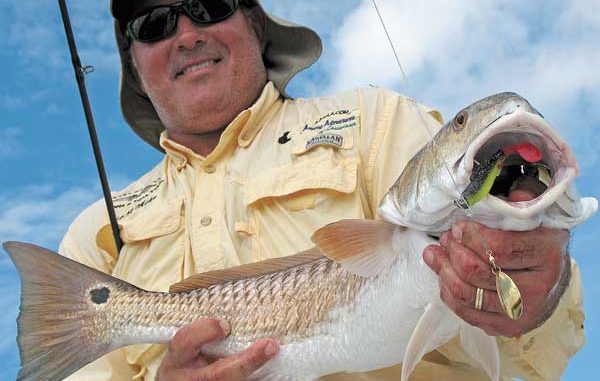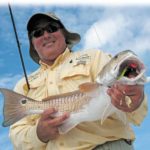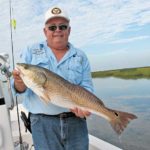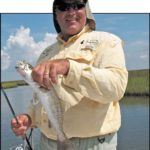
This section of marsh isn’t easy to get to, but that only adds to its charm and productivity.
Forty miles to the east of New Orleans in upper St. Bernard Parish lies a vast 40,000-acre swath of marshland known technically as the Biloxi Wildlife Management Area. The locals call it either the Louisiana Marsh or the Biloxi Marsh, but whatever you call it, the fringe lakes and bays produce some great speckled trout and redfish action this month.The whole gigantic marsh is riddled with canals, bayous, ponds and some nice-sized bodies of water as well. When the weather turns cold, the deeper bayous will hold specks and reds, and are favored haunts of many local anglers. When the tides are high, the shallow canals and ponds will hold hungry, hard-fighting redfish.
But according to Capt. Mike Gallo (985-781-7811), the best action this month is on the fringes of the Biloxi Marsh, where savvy anglers can find some good fish, and plenty of them.
Gallo invited me to accompany him and his long-time friend, Don Couvillion, on a recent excursion into the Biloxi Marsh to see if we could get into some of that action. We met Gallo at his camp on Highway 90, and hopped aboard his 22-foot bay boat for a trip across Lake Borgne into the top end of the marshland.
“Malheureax Point is the northernmost tip of the Biloxi Marsh, and it’s a good place to hunt for both reds and specks,” Gallo said. “You can work your way south from here along the shoreline on the Lake Borgne side, and fish the points and coves and drains from the marsh.
“I like to troll and cast toward the shore with spoons and spinners for reds, and I cast out toward the open water with live shrimp or soft plastics under popping corks for specks.
“If you get into some action, stick your Cajun anchor over, and see if the action will hold out for awhile. Then just continue drifting until you bump into them again.
“Another tactic is to fish the mouths of all the numerous bayous at Lake Borgne, such as Bayou Grande, Lakeshore Bayou, Bayou Biloxi, Bayou Magill, False Mouth Bayou, Cop Cop Bayou and Bayou LaFee, all of which can be very productive, especially on a falling tide.”
Gallo looks for any signs of bait activity in the water or birds diving, all of which are dead giveaways of action under the surface.
“Then I fish that area thoroughly with live shrimp or plastics under a popping cork,” he said. “But my favorite technique this month is to fish the upper east side of the Biloxi Marsh in the big fringe bays, where the white shrimp are migrating out of the marshes back into the open water, and the trout and redfish go into an absolute feeding frenzy.
“I’m talking about areas such as Blind Bay, Three Mile Bay, Nine Mile Bay, False Mouth Bay, Bay Boudreaux, Bob’s Lakes, Poodle Lake and Lawson Bay — the ‘Fringe Bays,’ I call them.”
We rounded Malheureax Point, and entered a small, shallow no-name bayou where Gallo killed the outboard and dropped the trolling motor over the bow.
“The tide is high right now and just beginning to fall, so we have a window of opportunity to fish back inside a couple of these shallow ponds,” he said, pointing straight ahead. “But it’s very shallow in here, and we’ll get stuck quick if we’re not watchful and let the water run out on us.”
We were in redfish country, and Gallo was tossing a beetle-spin as we slowly trolled within casting distance of the shoreline. Couvillion wisely stuck a live shrimp on a hook, and fished it about 12 inches under a popping cork. He’d park that shrimp at cuts and corners, and toss it down those skinny marsh drains, knowing that no hungry redfish would be able to resist them.
We didn’t get far into the pond before he had a nice fish hooked up, and he wrestled him back to the boat. We worked our way through that pond and then another, sighting redfish almost continuously, and managing to put our share into the boat.
“These two months, October and November, are really my two favorite months of the year to fish,” Gallo said. “The horrible heat and humidity of the summer give way to brisk mornings, and even the fish seem reinvigorated. As the white shrimp pour out of the marsh this month in particular, the trout and reds are hunting for them at these fringe bays, and I’ll be there hunting the hunters.”
Gallo, something of a homespun student of fish psychology, offered several tips and personal observations that are definitely worth noting.
“First, I consider the most likely routes the shrimp will take on their exodus from the interior marsh into the open water,” he said. “They are a lot like us when we evacuate for hurricanes. We take the main roads, the interstate highways, right? Well, so do the shrimp. They will flow down the main bayous and passages from the marsh into the outer bays.
“That means anglers should concentrate on those main passages, because where the bait is, that’s where the fish will be. Bob’s Bayou, Bayou Marron, Poodle Lake, Bayou Biloxi — anywhere that is a main passage draining the marsh.
“Second, you want to fish an area with a hard bottom. There are three kinds of bottom in the marsh — mud, a mixture of mud and clay, and sand. Oysters thrive on harder bottoms, and a main passage with an oyster bottom is the prime place to find trout. You know why? One sure reason is this — a shrimp flowing downcurrent with the tide can quickly burrow into a soft mud bottom and hide from predatory trout. But he can’t hide on a hard bottom, and that’s where the trout wait in ambush.
“So, you can fish familiar areas with a known hard bottom, or you can explore and find those areas on your own, and I’ll give you a couple tips on how to do that.
“The most obvious way is to simply look for oyster shells along the waterline, especially on lower tides. Generally, that indicates a decent rock bottom. To find out, tie a 1-ounce sinker on your line, cast it out and as you reel it in, let it dribble along the bottom. You’ll either feel it bouncing atop the oyster shells or digging into mud. Fan your casts and search that area, and if you feel a shell bottom, fish there.
“Another tip is something I discovered simply by observation. I often drift and troll these passageways, and when I find fish, I stick my Cajun anchor in the bottom, and try to sit on the action. I noticed that on many occasions when I stuck the anchor, I was over a hard bottom.
“And I also noticed something else I found interesting. Often in those hard-bottom areas, there was roseau cane growing on the bank. You know that most of the marsh is marsh hay, cordgrass, some three-square and rush, and you can run for miles and that’s all you’ll see. And then you come to a patch of roseau cane that breaks up the monotony. My observation, is that cane grows in areas with a harder bottom, not just that soft mud. So where you see cane, try tossing out that sinker again, and see if you can feel a hard bottom. If you do, fish there.”
Gallo also subscribes to the “move on” method of fishing. That is, if you work an area thoroughly and get no hits, move on. Or if all you get is those dinky nibbles on your line, just enough to make the cork bobble but never really disappear, move on.
“That is not trout biting,” he said. “It’s either pinfish or croaker or needlefish, and all they’ll do is steal your bait. If those bait stealers are present, there aren’t any trout or reds around. Think about it, will a croaker or a pinfish hang out in the same area as a much larger predator? They know they’d be fish food in an instant. So if your shrimp are being eaten by bait-stealers, move on.”
We put a two-man limit of reds in the boat, played catch-and-release for quite a while and then moved to bigger water to see if we could find some specks. I fished a glow DOA Shrimp under an Old Bayside Paradise Popper cork rig — normally a good combination, and this trip was no exception.
The artificial shrimp produced just as well as the live, which is one of the additional bonuses of fall fishing.
“Live bait, while always a producer, is not as essential as we move into the fall season,” Gallo said, “and the reason is simply that there is not as much bait in the water.”
Gallo says his favorite fall baits for specks besides live shrimp are Deadly Dudleys in pink champagne or purple haze under popping corks. He likes to use light jigheads under a cork, either 1/8- or even 1/16-ounce, because the lighter weight causes the bait to fall slower after you pop the cork, “and trout love to hit that bait as it falls,” he said.
And he prefers curl-tail plastics to paddle tails as the weather grows cooler.
“In the spring and summer, you pop the cork a lot to attract fish,” he said. “But in the cooler months, you pop the cork less and let the bait sit still under the cork longer. A curl-tail bait gives plenty of motion to attract the fish, even when the bait is sitting still.”
For reds, he sticks with the three S’s — shrimp, spinners and spoons — tossed up near to the shoreline.
“Those are the old standards that produce good redfish day in and day out,” he said. “Gold spoons, either 3/8- or ½-ounce; beetle-spins using either a glow/chartreuse, purple/chartreuse or purple/white plastic, and live or market shrimp under a cork. I also like the Berkley Gulp crabs fished up against the bank under a cork. They are very effective baits, and sometimes the reds will hit them when they ignore almost everything else.”
I already have a return trip on the schedule. Maybe I’ll see you out there.
Capt. Mike Gallo can be reached at (985) 781-7811.




